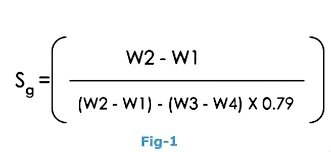Specific Gravity, also called relative density, is expressed as the ratio of the density of a substance to the density of a reference substance at a fixed temperature. Therefore, the ratio of mass or density of cement to the mass or density of a reference substance is specific gravity of cement. In both cases – mass and density – the volume should remain the same. If the volume is not identical, the specific gravity loses its meaning.
Specific or relative cement density is a ratio and hence, it has no unit.
Why to Calculate Specific Gravity of Any Substance?
The specific gravity of a substance is calculated to find out how the material behaves in water. It will help us know whether the material will float on the water or sink into it.
Every material in the environment is characterised by a fixed specific gravity. Usually it ranges from 1 to 100. If the specific gravity of a material is greater than 1, it will sink in water. On the other hand, if the specific gravity of a material is less than 1, it floats in water. Therefore, knowing specific gravity of any substance is important because it helps us figure out which commercial work it is best suited for.
In a nutshell, specific gravity tells us how much a particular material is heavier than a reference substance or water, given the volume of both being the same.
The specific gravity of cement is in the range of 3.1-3.16 g/cc. It implies that cement is 3.13.1 times heavier in respect to water of the same volume. The ratio also tells us that cement sinks in water because its specific gravity is greater than 1.
Every material has a plethora of tiny pores which may have void in them. Any material with voids in it becomes useless. If the cement has covering of extreme moisture content owing to bad weather conditions, the specific gravity of the cement jumps up to 3.19. If the specific gravity goes up so high, moisture gets into the pores.
Cement undergoes a chemical transformation after coming in contact with atmospheric moisture. This process is called hydration. Moisture harms the texture of cement, rendering it useless after its reaction with water. Excessive moisture creates a lot of lumps in old cement, leaving it of hardly any use.
Specific Gravity of Cement: Reference Substance
Most of the time, water is used as a reference substance to calculate the specific gravity of a material. The temperature of water used as a reference substance should be near 4°C.
For gases to be used as a reference substance, the ideal temperature should be 25°C, which is room temperature. However, if “Cement” is a sample substance, then kerosine should be used as the reference substance. This is due to cement forming calcium oxide after its reaction with water. But kerosene does not undergo any chemical reaction with cement.
Kerosine has a specific gravity of 0.79 g/cc.

What is the Importance of Specific Density of Cement?
- Of all the vital factors influencing concrete design, relative density of cement is extremely important. As the concrete mix concept has a volumetric nature, density is the most significant aspect to consider.
- Having an in-depth understanding of the specific gravity of cement is important because it is one of the most crucial components that factor in calculating the density of cement.
- The water-to-cement ratio is a crucial component of making perfect cement paste. It positively correlates with relationship integrity and productive capacity.
- Cement with specific gravity of 3.15 is used for making a nominal paste. If the value changes, it affects mix structure.
- In case the specific gravity of cement is greater than 3.19, it will negatively affect bonding properties.
How to Calculate the Specific Gravity of Cement?
It is fairly easy to calculate the specific gravity or relative density of cement. The Le Chatelier Flask Method is a useful way to find out the value of specific gravity of any substance. This method can be easily used at the site level to determine the specific gravity of cement.
Necessary Apparatus & Materials
The following materials and apparatus are required to calculate specific gravity of cement:
- Kerosene
- Ordinary Cement
- Weighing balance with 9.1 gm accuracy
- Le-Chatelier Flask of 250 ml or Specific Gravity Bottle / Pycnometer of 100 ml

Specific Gravity Calculation for Cement
The procedure to calculate the specific gravity of cement is done through 4 simple steps. The steps are described below:
- The flask, where the experiment will be held, should not have any liquid, implying that complete dryness of the container is a must-follow condition. Let us denote the weight of the flask as W1.
- Fill half of the flask with cement (around 50 gm). Weigh it and let us denote it as W2.
- Add kerosene to the cement and fill to the top of the bottle. Mix well so that air bubbles are removed. Let us denote the weight of the flask with kerosene and cement as W3.
- Empty the flask. Pour kerosene into the bottle and fill it fully. Let us now weigh the flask and denote it as W4.
Specific Gravity (Sg) = (W2-W1)/((W2-W1)-(W3-W4)×0.79)










